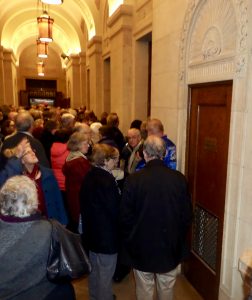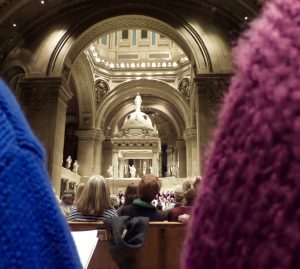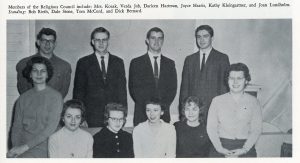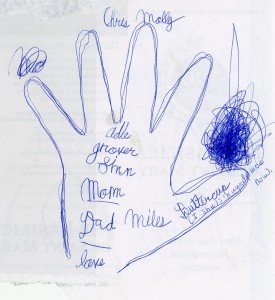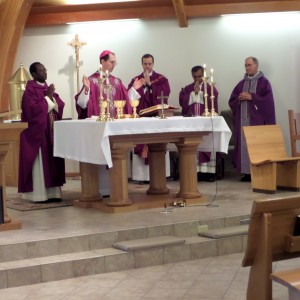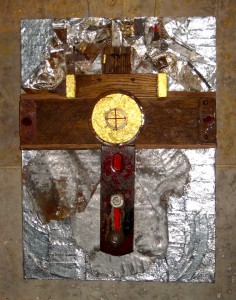The Reformation at 500 Years
500 years ago today, Martin Luther nailed his 95 theses to the church door at his home church in Germany. It basically was the beginning of the end of the First Reich (which most know as “the Holy Roman Empire“).
Saturday night we were privileged to be among over 1,000 people at Basilica of St. Mary for truly unique event. My “thank you” to Basilica of St. Mary and St. Olaf College: “The program Saturday night was magnificent, I would say, perfect in every way.” Saturday evening seemed to be more than just another program….
Basilica of St. Mary was filled for the concert featuring the famed St. Olaf Choir, and our similarly outstanding Basilica of St. Mary Choir. Here is the entire 1 1/2 hour program: My Soul Cries Out001
The program was free (with donations freely accepted mid-concert!); doors opened at 7:30 for the 8:00 performance. This gave time for a couple of snapshots:
(click to enlarge all photos, double click for more.)
Should anyone wonder: yes, we were orderly, and friendly, and patient, and the doors opened almost precisely on time at 7:30, and we walked in orderly fashion to our seats. Maybe I could ask you to pick out the Catholics and the Lutherans from amongst the group, but I am sure that there were far more than just those.
*
For myself, a lifelong Catholic whose growing up was in the not-so-good old days of the 1940s and 50s, and participating in the pews of my home church, the evening was an emotional event.
In my recollection, the splendid St. Olaf choir processed down the center aisle to the sanctuary area, and the Basilica choir began the concert in the choir loft high above the church. I’m not sure how the entrance was stage-managed, but I couldn’t help but muse that the entrance wasn’t one of triumph, or conquest, or capitulation. It was, rather, a profound showing of respect for everyone, by everyone.
Photos for a snapshot guy like me were all but impossible. Here is one where, if you look carefully, you can see some St. Olaf choristers in their purple robes, and some Basilica choir members in their off-white. Just click a second time.
Most of us in the church were at least generally aware of the hundreds of years of history which preceded this signal event, one of many in this 500th year of reflection on Protest-ant, and the 50th year after official dialogue began between Catholics and Lutherans.
Here’s a Lutheran explanation of the last 50 years.
Here’s a commentary by Dr. Johan van Parys in the Basilica magazine: van Parys spring 2017002
Here is a good reference point for the Lund Sweden reflections referenced in the program.
*
Of course, the Popes of the Catholic Church have not always been “saintly” in any sense of that term. Pope Leo X was Pontiff 1513-21. Luther had his own failings. We are all human beings, after all.
*
The concert got to thinking back to my own history as a Catholic, growing up in tiny rural towns in North Dakota. Pope Pius XII died in Oct. 1958 when I was a freshman in college; and Pope John XXIII (Saint John XXIII) was his successor and enabled the opening of the windows of the Catholic Church, ecumenism and renewing relationships with other denominations.
I grew up in the old days of separation and division, and entered college not knowing that I was entering a new era.
Back at home, Sunday, I decided to take a look at my old college annuals, and there in the 1961 annual was this page, including a surprising face: Interreligious Coun 1961001.
I remember five of those in the photo from 1960 or 1961. Our most important act, which had to be facilitated by elders of all denominations at the time, was the very fact that we met at all, and that we were recognized as a group.
*
It would seem to me, as an individual, that the best we can expect in our pluralistic country, is that we respect each others beliefs, whatever those beliefs happen to be. We’ve come a long ways. We have a long ways to go.
What Luther did back in 1517 needed doing.
The debate will always continue, but perhaps we are making a serious effort to change.
POSTNOTE: 3:45 p.m. Oct 31.
The spiritual dimension of life has always been important to me, much more so than the orthodox definitions of particular beliefs (which vary greatly, as we all know.)
What intrigues me is the interrelationship between temporal power, and the will of the people.
People perceived to be in power are the ones who make the rules; who enable, or disable initiatives for change.
When I rediscovered on Sunday the committee I had been part of in college, it was something of a revelation to me. I had forgotten any involvement in such an “inter-religious” venture, which would not have happened two years earlier.
In this particular instance, Pope John XXIII was effectively the moving party, encouraging taking a new look at ancient practices, including relations between different Christian denominations. This in turn enabled others at other levels to begin informal dialogues, and not just Catholic. In my small example, some committee at the college had to authorize the organization and the faculty member advisor, and the local ministers also needed to be at least somewhat interested in the dialogue. Absent such leadership, we certainly wouldn’t have been memorialized by a page in the college yearbook!
Of course, direct action by the people themselves is also a possibility, but as we all know who functions as leader, at even local levels, makes a lot of difference.
People have a lot of power, and must exercise it in their selection of leaders.

